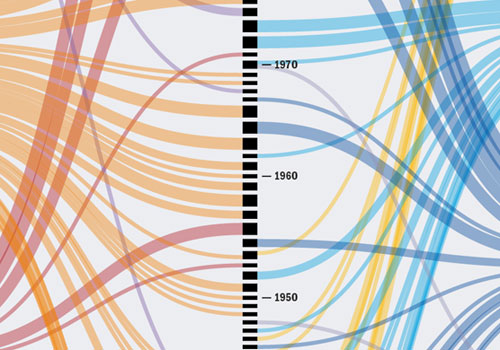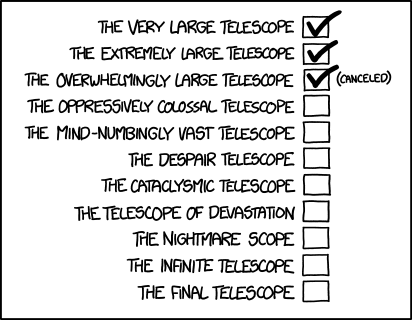Tag archives: Nobel prize
What type of physics should you do if you want to bag a Nobel prize?
By Hamish Johnston
Update on 16 October 2014: The 2014 prize has been added to the infographic.
At 11.45 a.m. CET (at the earliest) on Tuesday 7 October, the winner(s) of the 108th Nobel Prize for Physics will be announced in Stockholm. Like just about everyone else, I have no information about who will win – although I do have my suspicions (more on those tomorrow).
Predicting the future is never easy, but help is at hand with a new infographic that Physics World has created charting the history of the physics Nobel by discipline. Using the categories that we apply to articles on physicsworld.com, we have split the 107 prizes since 1901 into seven categories. If you click on the image above, you can see the infographic in all its glory.
The most popular discipline with Nobel committees through the ages is nuclear and particle physics, which accounts for nearly one-third of the prizes. As well as dominating the prizes in the 1950s and 1960s, nuclear and particle physics spreads its tentacles from the very first prize – to Wilhelm Röntgen for the discovery of X-rays – to last year’s prize, which went to François Englert and Peter Higgs for predicting a much more esoteric boson.
Interestingly, that very first prize in 1901 flags up an important challenge I faced while categorizing the prizes using contemporary disciplines. You could argue that when Röntgen discovered X-rays, he was doing atomic physics. Indeed, some of those X-rays would have come from atomic processes, while others would have been bremsstrahlung – which I would consider particle physics. However, because Röntgen accelerated electrons into a target and analysed the radiation produced, I decided that it was a particle-physics experiment.
View all posts by this author | View this author's profile
How the banjo got its twang, love in the time of science, award-winning astro images and more

Five string banjo showing the position of the bridge on the round head. (CC BY-SA 3.0 / DMacks)
By Tushna Commissariat and Hamish Johnston
Folk and country music often blends the sharp twang of a banjo with the mellow and sustained tone of a guitar. While the two instruments appear to be very similar – at least at first glance – they have very different sounds. This has long puzzled some physicists, including Nobel laureate David Politzer, who may have just solved this acoustical mystery.
View all posts by this author | View this author's profile
Winning rock-paper-scissors, meeting a future Nobel laureate, hot new batteries and more
By Hamish Johnston
When I was a PhD student, there was a group of retired professors that shared a tiny office in the physics department. It was whispered that one of them was extremely wealthy thanks to a successful commercial spin-out and we marvelled at the fact that he came in to work every day rather than enjoying the fruits of his labours. However, it wasn’t the wealthy professor who was destined for international fame. In 1994 his officemate Bertram Brockhouse shared the Nobel Prize for Physics, and Brockhouse’s quiet life changed dramatically. Indeed, he got his own office!
I was reminded of this little group when I read ZapperZ’s blog entry about his encounter with Ray Davis before Davis bagged the 2002 Nobel for his work on neutrinos. Sitting next to Davis on a two-hour flight, ZapperZ had an inkling that he was beside an interesting character after their brief chat about physics. But it wasn’t until the Nobel was announced several years later that he realized the opportunity he had missed.
View all posts by this author | View this author's profile
Cakes that are out of this world, what’s on Andre Geim’s iPod and who’s the April fool?
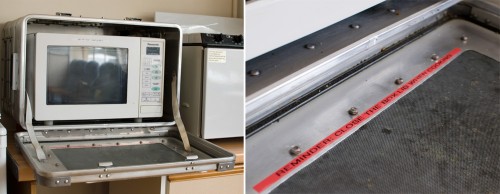
The joke’s on me: click on the image for a larger version where you can see the instruction for users
By Hamish Johnston
On Tuesday I was feeling particularly pleased with myself over the April Fool’s piece that I penned. It was about a fictitious microwave-oven ban organized by radio astronomers at the UK’s Jodrell Bank Observatory. But now it looks like I might have a bit of microwaved egg on my face because two of my colleagues visited Jodrell Bank this week and guess what? Astronomers there have built a Faraday cage around the microwave in their tearoom to stop it from interfering with their equipment. Louise Mayor took the above photos: click on the image to read the reminder to microwave users.
View all posts by this author | View this author's profile
The future of energy in Gothenburg
By Michael Banks
Yesterday I joined more than 1000 people attending the day-long Nobel Week Dialogue event in Gothenburg, Sweden. The delegates battled the cold winter weather to make it to the Swedish Exhibition and Congress Centre, just south-east of the city centre (and next to a theme park, of all things).
This is the second such Nobel Week Dialogue and the first time it has been held in Gothenburg. Last year the theme for the event in Stockholm was the “genetic revolution” and this year it was on “exploring the future of energy”.
View all posts by this author | View this author's profile
Safe graphene, Martian mollycoddling, mathematical tales and more
By Tushna Commissariat
Just when we thought that it couldn’t possibly have any more practical applications, everybody’s favourite “wonder material” graphene is going to be used to develop “stronger, safer, and more desirable condoms”. Thanks to a Grand Challenges Explorations grant of £62,123 from the Bill and Melinda Gates Foundation, scientists at the University of Manchester will use graphene to develop new “composite nanomaterials for next-generation condoms, containing graphene”. Unsurprisingly, the story made all the national newspapers with the BBC, the Guardian, the Telegraph and the Independent all having their say. The Guardian also noted that industrial graphene-producer Applied Graphene Materials’ shares jumped by 40% during its stock-market debut, the day before the above story broke. You can read more about graphene’s many potential applications on page 50 of Physics World’s anniversary issue, a free PDF download of which is available here.
View all posts by this author | View this author's profile
Nobel trivia, turn your phone into a spectrometer and more
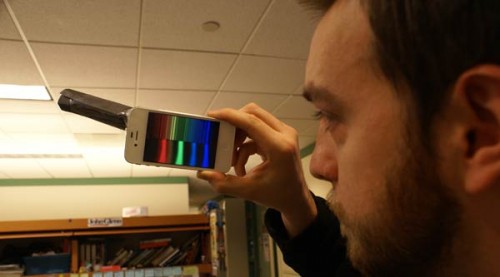
APS Outreach Specialist James Roche shows off SpectraSnapp. (Courtesy: Mike Lucibella/APS)
By Hamish Johnston and Tushna Commissariat
This was Nobel week, and physicists had two prizes to celebrate this year. Of course there was the prize for physics, which this year went to Peter Higgs and François Englert for their theoretical prediction of the Higgs boson in 1964.
Shortly after the physics-prize announcement, Englert was on the phone to Stockholm, but the Nobel officials couldn’t seem to find Higgs. Early rumours were that he had retreated to the Highlands of Scotland to avoid the media glare, but a few hours later he was photographed outside his Edinburgh home by The Scotsman newspaper.
Later, the BBC reported that Higgs was told about his Nobel win by a passer-by on an Edinburgh street, who stopped her car when she spotted the physics laureate on the pavement. “She congratulated me on the news and I said ‘Oh, what news?’,” Higgs is quoted as saying.
View all posts by this author | View this author's profile
Who will bag the 2013 Nobel prize?
By Michael Banks
Yep, it’s that time of year again, when predictions for the Nobel prize get bandied about and notable physicists will be making sure that their mobile phones are fully charged in anticipation of a call from Stockholm.
The 2013 Nobel Prize for Physics will be announced on Tuesday 8 October at 11:45 CET. Work on the Higgs boson, which was discovered last year at CERN’s Large Hadron Collider, is the surely the hot favourite to win this year, but the Nobel Foundation sometimes springs surprises and 2013 may be no different.
So who do you think will win this year’s prize?
View all posts by this author | View this author's profile
Nobel laureate Andre Geim profiled on BBC radio
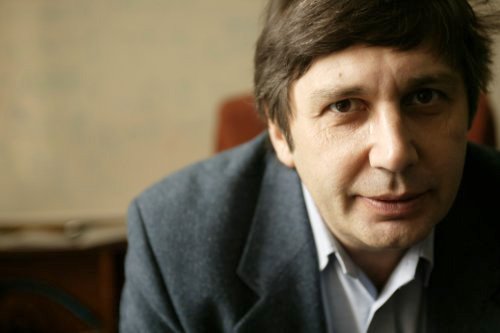
Nobel laureate Andre Geim. (Courtesy: University of Manchester)
By Hamish Johnston
I thoroughly enjoyed a recent BBC Radio 4 profile of Andre Geim of the University of Manchester, who shared the 2010 Nobel Prize for Physics. In the 13 minute broadcast, which is available for download, Geim and several admirers talk about the passion for doing quirky fundamental research that led to his co-discovery of graphene.
There is even the bold suggestion from one of Geim’s colleagues that there might be another Nobel in the Russian-born physicist.
View all posts by this author | View this author's profile
Which Nobel-prize-winning physics invention has had the most profound impact on society?
By James Dacey

Physics has brought transformative inventions. (Courtesy: iStockphoto/Péter Mács)
Earlier this week my colleague reported the death of Heinrich Rohrer, the Swiss condensed-matter physicist who shared the 1986 Nobel Prize for Physics for the invention of the scanning tunnelling microscope (STM) at IBM’s Zürich Research Laboratory. Rohrer shared one half of the prize with his IBM colleague Gerd Binnig, while the other half went to the West German Ernst Ruska for his invention of the electron microscope (EM).
By bringing into view the atomic world, EMs and STMs have undoubtedly had a huge impact on science. Before their invention, optical microscopy had been a truly transformative technology. But it had been fundamentally limited to seeing things that are (roughly speaking) larger than the wavelength of the light used to produce the image. And since the wavelength of visible light is some 10,000 times larger than the typical distance between two atoms, we could not see individual atoms.
